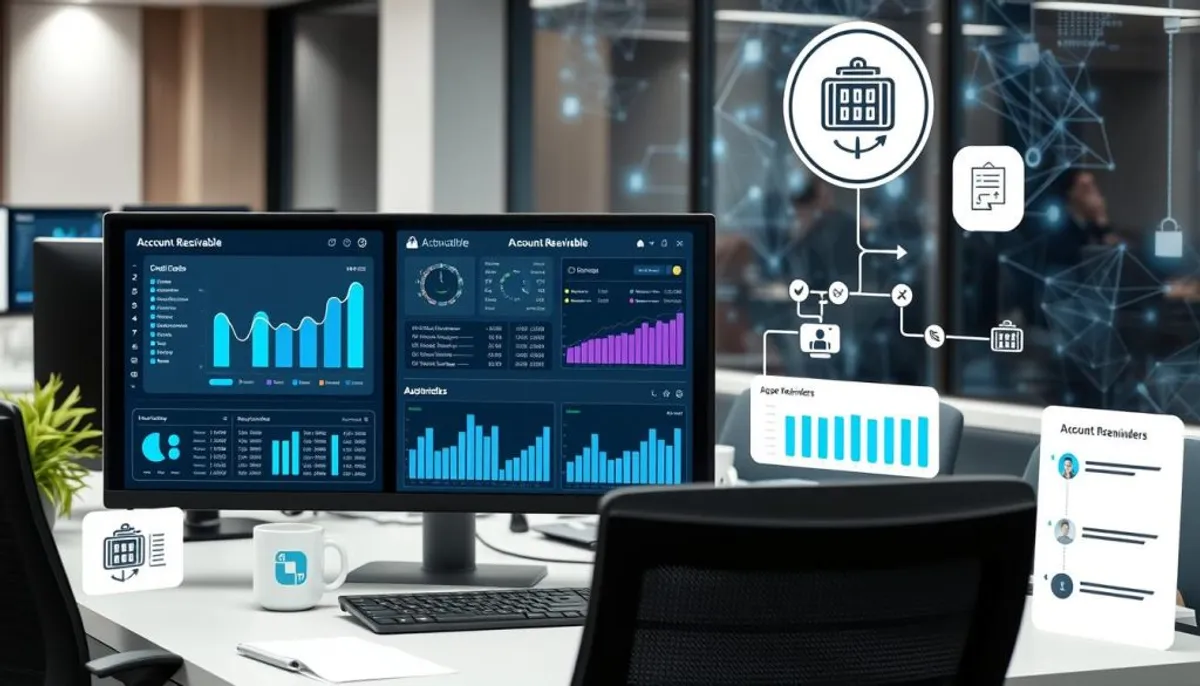Struggling with unpaid invoices and cash flow issues is common among businesses. Effective accounts receivable systems can revolutionize your collections management and cash flow tracking. They are essential for maintaining financial health.
Modern AR automation can cut cash collection time by 80%. Streamlining billing and using electronic payments enhances cash flow and customer relations. This approach is transformative.

One overdue invoice can severely impact your financial health. It’s vital to have a system that identifies and addresses past-due accounts promptly. The right tools automate payment reminders, offer flexible payment plans, and facilitate partnerships with collection agencies.
Optimizing AR processes is crucial. We will cover the basics, advanced strategies, and cutting-edge technologies. You’ll learn about AR audits, effective collection strategies, and key metrics like DSO and CEI.
Key Takeaways
- Implement AR automation to reduce cash collection time by up to 80%
- Use electronic billing and online payments to streamline customer transactions
- Monitor key metrics like DSO and CEI to improve collections efficiency
- Automate payment reminders for past-due accounts
- Offer flexible payment options to encourage prompt payments
- Regularly review and optimize your AR processes for better cash flow
Understanding the Fundamentals of Accounts Receivable Systems
Accounts receivable systems are crucial for a company’s financial well-being. They manage invoice processing, customer billing, and credit control. This ensures a smooth cash flow and efficient financial operations.
Core Components of AR Systems
AR systems consist of several key elements. These elements work together to streamline collections. They include tools for creating and sending invoices, tracking payment due dates, and following up on late payments.
Automated reminders and payment reconciliation features are also crucial. They help maintain accurate records.
Benefits of Structured AR Management
Implementing a structured AR system offers numerous advantages. It promotes timely payments, enhances client relationships, and improves liquidity. For instance, a well-managed AR process can significantly reduce the average sales credit period.
In 2021, a company with an efficient system saw customers paying bills in just 1.73 weeks on average.
Impact on Business Cash Flow
Effective AR management has a substantial impact on cash flow. It minimizes accounting errors, prevents revenue loss, and reduces wasted staff time. Companies can better estimate uncollectible accounts, typically setting aside about 5% of total sales for potential bad debts.
| AR Metric | Impact on Business |
|---|---|
| Accounts Receivable Turnover Ratio | Indicates payment speed from customers |
| Days Sales Outstanding (DSO) | Measures average collection time after sale |
| Net Receivables Percentage | Reflects collectible vs. uncollectible debts |
By leveraging these metrics and implementing robust AR systems, businesses can optimize their cash flow management. This maintains strong financial health.
The Evolution of Modern Collections Management
Collections management has undergone a remarkable transformation in recent years. The shift towards digital transformation has revolutionized how businesses handle their accounts receivable processes. Gone are the days of paper-based systems and manual tracking. Today’s AR landscape is characterized by automation, efficiency, and data-driven decision-making.
One of the most significant changes is the adoption of electronic billing and online payment systems. These innovations have streamlined payment cycles, reducing errors and accelerating cash flow. Automated reminders have become a game-changer, with personalized messages increasing on-time payments and improving collection rates.
The integration of AR systems with accounting software has enabled real-time data synchronization. This integration provides finance teams with improved visibility into AR health, allowing for more proactive management strategies. Cloud-based solutions offer accessibility, scalability, and enhanced security, addressing the evolving needs of modern businesses.
| Traditional AR Management | Modern AR Management |
|---|---|
| Manual invoice generation | Automated invoice creation |
| Paper-based billing | Electronic billing solutions |
| Manual payment reminders | Automated, personalized reminders |
| Limited data analysis | AI-powered predictive analytics |
The impact of these advancements is significant. Businesses leveraging modern AR systems report reduced bad debt write-offs, faster payment cycles, and improved customer relationships. With AI and predictive analytics, companies can now forecast payment patterns and take proactive measures to optimize cash flow management.
Key Features of Effective AR Systems
Effective accounts receivable (AR) systems revolutionize financial management for businesses. They introduce a suite of features designed to streamline operations and enhance efficiency.
Automated Invoice Generation
AR systems automate the creation and dispatch of invoices, minimizing errors and accelerating the billing cycle. This automation frees up time and resources, allowing companies to allocate them more productively.
Payment Processing Integration
Seamless payment processing is indispensable. AR systems integrate with a variety of payment gateways, facilitating smooth transactions. This integration ensures that both customers and businesses can track payments effortlessly, fostering a more efficient payment reconciliation process.
Reporting and Analytics Tools
AR systems are equipped with advanced reporting and analytics tools. These tools provide businesses with comprehensive insights into their financial health. By tracking metrics such as Days Sales Outstanding, companies can make informed financial decisions, driving growth and stability.
Customer Communication Features
Effective customer communication is crucial for timely payments. AR systems automate reminders and personalized messages regarding outstanding invoices. This proactive approach not only streamlines the payment process but also strengthens customer relationships.
| Feature | Benefit |
|---|---|
| Automated Invoicing | Reduces errors by 90% |
| Payment Integration | Speeds up cash flow by 25% |
| Analytics Tools | Improves decision-making by 40% |
| Communication Features | Increases on-time payments by 30% |
The synergy of these features empowers AR systems to expedite payments, diminish errors, and optimize cash flow. By leveraging a robust AR system, businesses can redirect their focus towards growth and development, rather than being bogged down by payment-related tasks.
Implementing Digital Transformation in Collections

The digital revolution is profoundly altering collections processes. Businesses are transitioning away from traditional methods, with check usage for B2B payments plummeting to a record low of 33%. This shift towards electronic billing and online payments is significantly streamlining customer transactions and dramatically reducing processing times.
AR automation is at the forefront of this transformation. It can reduce cash collection time by up to 80%, liberating staff from mundane tasks such as preparing reminders and pulling invoices. Advanced data capture ensures continuous performance enhancement, while AI and machine learning automate payment matching with remittance data.
Online payment portals are becoming indispensable, enabling customers to initiate card and ACH payments effortlessly. These digital solutions offer numerous advantages:
- Improved cash forecasting
- Quick and cost-efficient fund application
- Enhanced security through reduced client data storage
- Easy tracking of payments and receipts
By embracing digital transformation, businesses can future-proof their collections processes. Cloud computing, data analytics, and automation optimize operations and enhance decision-making. This digital leap not only improves efficiency but also strengthens customer relationships by providing clear insights into outstanding balances and payment requirements.
Streamlining Invoice Processing and Payment Workflows
Enhancing efficiency in invoice processing and payment workflows is crucial for businesses. This effort minimizes errors, accelerates payment cycles, and optimizes cash flow. We will examine essential strategies to refine these critical processes.
Electronic Billing Solutions
Electronic billing revolutionizes the invoicing landscape for enterprises. It enables swift, professional invoice generation with customized branding. Such systems also include features for tracking invoices, including payment due dates and automatic reminders for late payments. This digital transformation dramatically reduces the time and effort required for billing.
Payment Gateway Integration
Integrating payment gateways into invoicing systems streamlines the payment process for clients. It introduces a variety of online payment methods, simplifying the payment process for customers. This integration facilitates quicker payment collections and enhances cash flow forecasting.
Reconciliation Automation
Automating reconciliation is vital for maintaining accuracy and efficiency. The 3-way matching process ensures that purchase orders, goods receipt notes, and supplier invoices are in alignment. This method prevents unauthorized charges and guarantees that payments are only made for valid transactions.
| Process | Benefits | Impact |
|---|---|---|
| Electronic Billing | Faster invoice creation, automated reminders | Reduced billing cycles, improved cash flow |
| Payment Gateway Integration | Multiple payment options, easier client payments | Accelerated collections, better cash forecasting |
| Reconciliation Automation | Accurate matching, fraud prevention | Reduced errors, increased financial transparency |
By adopting these strategies, businesses can notably enhance their invoice processing and payment workflows. This results in expedited payments, lower Days Sales Outstanding (DSO), and a more robust financial performance.
Credit Control and Risk Management Strategies
Implementing effective credit control and risk management is essential for businesses. A critical component of this is credit risk assessment. This involves evaluating a customer’s financial standing before extending credit. It encompasses examining credit scores, income statements, and payment history.
Businesses employ various tools to gauge credit risk. These include credit risk scores and assessment models. These tools forecast the likelihood of default and potential financial losses. This enables businesses to make informed decisions regarding credit extension.
Payment terms are pivotal in managing risk. Regular assessments of these terms ensure they remain fair and current. Offering early payment discounts can incentivize customers to settle their accounts promptly, enhancing cash flow.
- Set reasonable credit limits
- Review payment terms often
- Consider early payment discounts
- Monitor accounts receivable metrics
Monitoring accounts receivable is indispensable. Aging reports reveal unpaid invoices and their duration. This aids in identifying payment patterns and high-risk customers. It is advisable to review these reports frequently, not just annually.
Effective credit control transcends mere avoidance of bad debt. It fosters robust customer relationships while safeguarding the business. By adopting the right strategies, businesses can achieve growth while maintaining financial stability.
Introducing ti3: Revolutionary AR Management Platform
The ti3 platform is transforming accounts receivable management. It introduces a novel approach to managing overdue accounts and enhancing collections processes.
Platform Overview and Capabilities
Ti3 is a cloud-based solution aimed at efficiently addressing unpaid invoices. It combines intelligent automation with tailored communication to maintain a healthy cash flow. The platform’s intuitive interface simplifies managing overdue accounts, even for smaller businesses.
Automation Features and Benefits
The automation capabilities of ti3 distinguish it from conventional collection methods. Key features include:
- Customizable reminder schedules
- Multi-channel communication options
- Automated payment follow-ups
- Smart issue escalation
These features significantly reduce time and human error, ensuring consistent follow-up on overdue accounts. By automating mundane tasks, your team can concentrate on nurturing customer relationships and resolving intricate issues.
Integration with Existing Systems
Ti3 excels in system integration. It integrates seamlessly with well-known accounting software such as Xero and QuickBooks. This integration keeps your AR data current across all platforms, eliminating data silos and enhancing precision.
| Feature | Benefit |
|---|---|
| Automated Reminders | Timely follow-ups without manual effort |
| Multi-channel Communication | Reach customers through their preferred method |
| Software Integration | Seamless data flow between systems |
| Customizable Workflows | Adapt to your unique business processes |
Customer Relationship Enhancement Through AR Systems
AR systems are pivotal in fortifying customer relationships. They streamline processes and enhance communication, resulting in superior experiences. Recent statistics underscore the significance of effective AR management in fostering enduring customer connections.
Proactive payment reminders are a cornerstone of modern AR systems. They ensure timely payments and maintain positive relationships. An astonishing 85% of executives attribute incomplete payments to poor communication between the AR team and customers. This highlights the necessity for clear, consistent communication throughout the collection process.

Efficient dispute resolution is another critical component of AR systems. With 41% of executives noting that invoice disputes directly correlate to relationship breakdowns, having a robust system for addressing concerns promptly is crucial. AR systems provide tools for swift issue identification and resolution.
Offering flexible payment options is yet another way AR systems boost customer satisfaction. Less than 2 in 5 businesses have incorporated self-service customer payment portals, presenting a significant opportunity for enhancement. By providing such options, businesses can align with customer preferences and streamline the payment process.
| AR System Feature | Impact on Customer Relationship |
|---|---|
| Proactive Payment Reminders | Ensures timely payments, reduces miscommunication |
| Efficient Dispute Resolution | Addresses concerns promptly, maintains goodwill |
| Flexible Payment Options | Improves customer satisfaction, streamlines process |
By harnessing these features, businesses can substantially enhance their customer relationships while optimizing their collections process. This results in a mutually beneficial outcome: improved cash flow for the business and enhanced customer experiences.
Metrics and Performance Tracking in AR Management
Effective accounts receivable (AR) management hinges on tracking critical metrics. These metrics are pivotal for optimizing cash flow and enhancing financial health. We will examine essential KPIs, data analytics, and strategies for optimizing AR management performance.
Key Performance Indicators
AR professionals employ various KPIs to gauge collection efficiency:
- Days Sales Outstanding (DSO): Measures average time to collect payments
- Accounts Receivable Turnover Ratio: Evaluates credit management efficiency
- Collection Effectiveness Index (CEI): Assesses ability to collect funds in a timeframe
- Average Days Delinquent (ADD): Tracks average time invoices remain overdue
Data Analytics and Reporting
Data analytics tools offer insights into AR performance. These tools generate reports on payment trends, customer behavior, and collection rates. By analyzing this data, businesses can pinpoint areas for enhancement and make strategic decisions.
Performance Optimization Strategies
To elevate AR performance, consider these strategies:
- Set targets for each KPI and review regularly
- Implement automated reminders for overdue invoices
- Personalize communication with customers
- Conduct periodic credit reviews to manage risk
- Streamline invoice processing and payment workflows
By concentrating on these metrics and strategies, businesses can refine their AR management. This leads to enhanced cash flow and overall financial health.
Best Practices for Dispute Resolution and Deductions Handling
Effective dispute resolution and deductions handling are vital for maintaining healthy customer relationships and optimizing cash flow. By adopting best practices, businesses can streamline these processes. This leads to improved overall accounts receivable management.
A structured approach to dispute resolution involves several key steps:
- Prompt acknowledgment of disputes
- Clear communication throughout the process
- Thorough documentation of all interactions
- Defined timelines for resolution
For deductions handling, automated systems can flag potential issues early. This enables quick investigation and resolution. Training AR staff in customer service skills is essential. It helps in handling disputes professionally and maintaining positive customer relationships.
| Dispute Type | Description | Resolution Approach |
|---|---|---|
| Pricing | Differences in invoiced amounts and agreed prices | Review contracts, negotiate adjustments |
| Quality | Questioned quality of products or services | Investigate claims, offer replacements or credits |
| Administrative | Missing or inaccurate documents | Provide required documentation, correct errors |
| Unaccounted Goods | Billing for items not in agreement | Verify order details, adjust invoices |
| Double Billing | Invoicing a delivery twice in error | Identify duplicate charges, issue credit notes |
By implementing these best practices, businesses can significantly improve their dispute resolution and deductions handling processes. This leads to enhanced customer satisfaction and more efficient accounts receivable management.
Security and Compliance in AR Systems
In the realm of accounts receivable, data security and adherence to compliance regulations are paramount. AR systems manage sensitive financial data, making them attractive targets for cyber threats. To safeguard your enterprise and its clientele, it is imperative to deploy stringent security protocols.
Business email compromise (BEC) is a prevalent cybercrime strategy aimed at manipulating invoices. Criminals exploit vulnerabilities in system linkage points, underscoring the need to fortify these areas. The presence of third-party vendors within your supply chain also introduces potential security risks to AR systems.
Cloud services are indispensable to AR functionality, yet ensuring secure connections is of utmost importance. With the rise of remote work, AP personnel may encounter heightened security threats when utilizing personal devices or unsecured networks.
- Implement multifactor authentication
- Use access management tools
- Establish strict data storage procedures
- Conduct automated scans and data analytics
- Educate employees on security best practices
Payment security is a critical component of AR systems. Integrating secure payment gateways and adhering to PCI DSS standards is essential to safeguard sensitive financial information. Regular security audits and staff training on compliance regulations are vital to maintaining a secure and compliant AR environment.
By prioritizing data security, adhering to compliance regulations, and maintaining robust payment security measures, businesses can protect their AR systems. This approach fosters trust with customers and ensures the integrity of financial transactions.
Conclusion
AR optimization is a vital strategy for businesses seeking to enhance their financial standing. By adopting cutting-edge accounts receivable systems, enterprises can significantly improve their cash flow and collection efficiency. The transition to automated processes has yielded remarkable outcomes, with companies saving up to 80% per invoice through AR management solutions.
The integration of cloud-based accounting software and online payment gateways has transformed the AR sector. These innovations not only streamline operations but also offer real-time insights into cash flow, essential for effective financial oversight. By providing a range of payment options, businesses can increase the chances of timely payments, thus alleviating the strain of overdue accounts.
Platforms like ti3 lead the charge in this digital evolution, offering comprehensive AR management solutions. These systems seamlessly integrate with existing systems, automating tasks from invoicing to reconciliation. This leads to a more efficient, precise, and customer-centric AR process, fostering overall business growth and stability.
Looking ahead, the emphasis on AR optimization will persist, driving further improvements in cash flow and collection efficiency. By harnessing technology, implementing best practices, and fostering clear communication with customers, businesses can establish a solid financial base for enduring success in a rapidly changing market.
RelatedRelated articles



